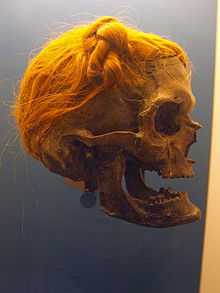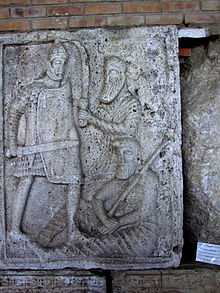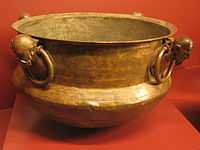Suebian knot


The Suebian knot (German: Suebenknoten) is a historical male hairstyle ascribed to the tribe of the Germanic Suebi. The knot is attested by Tacitus in his 1st century AD work Germania, found on art by and depictions of the Germanic peoples, and worn by bog bodies.
Germania
According to Germania by Tacitus, the Suebian warriors combed their hair back or sideways and tied it into a knot, allegedly with the purpose of appearing taller and more awe-inspiring on the battlefield. Tacitus also reports that the fashion had spread to neighboring Germanic tribes among the younger warriors, while among the Suebians, the knot was sported even by old men as a status symbol, which "distinguishes the freeman from the slave", with the most artful knots worn by the most wealthy nobles.[1]
Archaeological record
Suebian knots were found to be worn by a number of bog bodies:
- Osterby Man,[2] 70-220 AD of Osterby near Rendsburg-Eckernförde, Schleswig-* Holstein, Germany
- Dätgen Man,[3] 135–385 AD, and Dätgen, near Rendsburg-Eckernförde, Schleswig-* Holstein, Germany
In 2000 at the Baltic Sea coast at Czarnowko near Lębork, Poland, a bronze kettle was found depicting males wearing the Suebian knot hairstyle.[4]
Depictions
Historical depictions are found on the Trajan column, the cauldron of Musov, the Tropaeum Traiani relief, and a bronze sculpture of a kneeling German in the Bibliothèque nationale de France.
Gallery
-

A Suebian knot depicted on the coat of arms of Osterby, Schleswig-Holstein, Northern Germany.
-

Marble head form Somzée, Belgium
-

Hairs of bog body Dätgen Man (Germany)
-

A Roman bronze figurine depicting a kneeling Germanic man adorned with a Suebian knot Bibliothèque nationale de France
-
German at Wien Museum
-
Portonaccio sarcophagus (Man on the lower right side)
-

Terra cotta mask at British Museum
-

Mušov cauldron
-
Suebian Knot Roman POW at National Museum of Romanian History
See also
References
| Wikimedia Commons has media related to Suebian knot. |
- ↑ "Germania". www.ourcivilisation.com. Retrieved 2013-12-19.
|chapter=ignored (help) - ↑ Deem, James M (2003). Bodies from the Bog. Houghton Mifflin Harcourt.
- ↑ Datgen Man. Mummytombs.com. Retrieved on 30 May 2012.
- ↑ M. Macynska, D. Rudnicka, Abstract: A grave with Roman imports from Czarnówko, Lębork district, Pomerania, Poland
| ||||||||||||||||||||||||||||||||||||||||||


